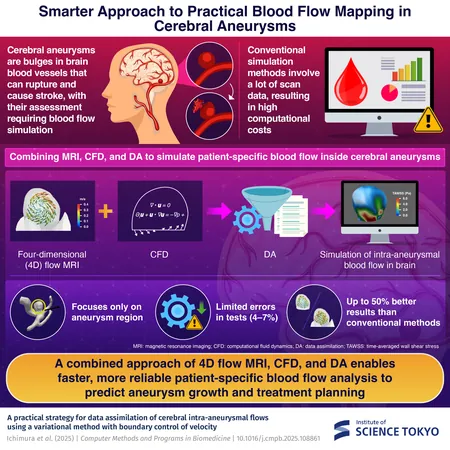
Revolutionary Blood Flow Simulation Model Enhances Brain Aneurysm Analysis with Unprecedented Accuracy and Efficiency
2025-07-11
Author: Ming
Breakthrough in Brain Aneurysm Research
In a groundbreaking advancement, researchers from Japan have unveiled a cutting-edge computational method to simulate blood flow within brain aneurysms. By ingeniously merging 4D flow MRI, computational fluid dynamics (CFD), and data assimilation, this innovative approach not only elevates accuracy but also enhances efficiency, making it a game-changer in the field.
Focusing on the Critical Zone
The team's strategy hones in on the aneurysm region alone, significantly slashing computational costs while boosting flow estimations. Validated against real patient data, this new model outshines conventional techniques, offering a tangible tool for creating patient-specific risk assessments and tailored treatment strategies.
Understanding the Danger of Brain Aneurysms
Brain aneurysms, also referred to as cerebral aneurysms, are bulging formations that occur due to weakened blood vessel walls. They can result from various factors, including high blood pressure, genetic predispositions, and unhealthy lifestyles. When these aneurysms rupture, the consequences can be dire, potentially resulting in stroke or death. Therefore, accurately assessing blood flow within these vulnerable areas is crucial to evaluate rupture risks effectively.
Outdated Methods Limit Clinical Application
Existing methods, such as phase-contrast MRI and CFD, face limitations due to their demands for high spatiotemporal resolution and patient-specific data. Although the use of variational data assimilation presents an opportunity for optimization, previous models often necessitated extensive computational resources by analyzing entire vascular systems, thus hindering their practical application in clinical settings.
A Smarter Approach for Better Outcomes
Professor Satoshi Ii and his team at the Institute of Science Tokyo have achieved a remarkable breakthrough by focusing exclusively on the aneurysm region. This innovative approach leverages limited MRI data to scrutinize flow velocities at the aneurysm's neck, which is essential for effective CFD simulations. By employing variational data assimilation, the team successfully estimates a comprehensive velocity profile within the aneurysm.
"Our method avoids the necessity of modeling the entire vascular system," Professor Ii explained. "Even with minimal data, we achieved simulations that remarkably replicate patient-specific blood flow patterns with high accuracy."
Impressive Validation Results
The effectiveness of this method was rigorously validated using both synthetic and authentic patient datasets. In simulations, the velocity discrepancy between the new model and the benchmark was a mere 4%–7%. Real patient data revealed a 37%–44% reduction in velocity errors when compared to traditional 4D flow MRI and CFD models. This demonstrates its superior efficiency and capacity to depict realistic flow patterns using limited data and minimal computational power.
Innovative Mathematical Techniques Yield Major Advances
The secret to this model's success lies in its innovative use of Fourier series-based model order reduction. This mathematical optimization simplifies the representation of variable blood flow, drastically lowering computational complexity while eliminating fluid dynamics errors. Furthermore, the new model not only simulates flow with enhanced accuracy but also provides valuable insights into critical factors such as wall shear stress and pressure.
A Game-Changer for Neurosurgery and Radiology
By harnessing data assimilation techniques to concentrate on the aneurysm zone, this method adeptly navigates the challenges associated with interpreting noisy MRI scans of full vascular branches. The implications are profound: "This approach could prove invaluable for neurosurgeons and radiologists," concludes Professor Ii. "The precise evaluation of patient-specific blood flow using this method may facilitate earlier predictions of aneurysm growth and rupture, thereby supporting proactive medical interventions and improved patient care."


 Brasil (PT)
Brasil (PT)
 Canada (EN)
Canada (EN)
 Chile (ES)
Chile (ES)
 Česko (CS)
Česko (CS)
 대한민국 (KO)
대한민국 (KO)
 España (ES)
España (ES)
 France (FR)
France (FR)
 Hong Kong (EN)
Hong Kong (EN)
 Italia (IT)
Italia (IT)
 日本 (JA)
日本 (JA)
 Magyarország (HU)
Magyarország (HU)
 Norge (NO)
Norge (NO)
 Polska (PL)
Polska (PL)
 Schweiz (DE)
Schweiz (DE)
 Singapore (EN)
Singapore (EN)
 Sverige (SV)
Sverige (SV)
 Suomi (FI)
Suomi (FI)
 Türkiye (TR)
Türkiye (TR)
 الإمارات العربية المتحدة (AR)
الإمارات العربية المتحدة (AR)